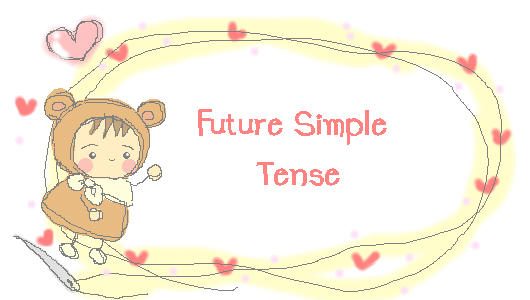Future Simple



โครงสร้าง = S + will / shall + V1
หลักการใช้
1. ใช้เมื่อจะมีการกระทำอย่างหนึ่งเกิดขึ้นในอนาคต shall ใช้กับบุรุษที่ 1 (I , We) ส่วน will ใช้กับบุรุษที่ 2, 3
(You , he , they , etc..) และคำนามทั่วไป (Jane , Tom , John and Mary, etc..) แต่ในปัจจุบัน
เราใช้ will ได้กับทุกบุรุษสรรพนาม
คำวิเศษณ์ที่บอกเวลา (Adverbs of time) สำหรับการกระทำที่จะเกิดขึ้นในอนาคต มีดังนี้
soon , shortly , in a short time , in a moment , in a while , in a week's time , in two days' time , in the future , in a few minutes (days , weeks , months, etc..) tonight , tomorrow , next week (month , year, Monday, etc..) later (on) = afterwards , from now on (ตั้งแต่เวลานี้เป็นต้นไป)
- The play will begin in ten minutes' time.
- The test tomorrow will be on everything in the book from Text 15 to Text 20.
- We will finish "The Future Tense" next Friday.
- I will try my best from now on.
2. ประโยคแสดงอนาคตที่มีกริยา 2 ตัว ให้ใช้ future simple กับกริยาเพียวตัวเดียวตัวหนึ่ง ใช้
present simple หรือ present perfect กริยาที่ใช้รูป future simple คือ คำกริยาซึ่งอยู่หน้าคำเชื่อม
คำเชื่อมที่พบมาก ได้แก่ when , until , as soon as , before , after , the moment (that) ,
by the time that , now that , unless, unless, when, until,as soon as, before , after ,now that
- We will go if we have time.
- When they get here, you 'll see how tired they are.
- They cannot leave until they do(have done) their work.
- He will visit you after he has had something to eat.
- Now that you have won the lottery , what are you going to do?
(คำ after , now that , when (ในความหมายของ after) นิยมใช้กับ Present Perfect)
3. การกระทำที่มีการตัดสินใจที่จะทำหลังการถามเสร็จสิ้น โดยไม่ได้มีการวางแผนมาก่อนล่วงหน้า
- John : Can anybody help me , please?
Helen : Yes, I'll help you. (มีการตัดสินใจว่าจะช่วยหลังจากที่ John ถาม)
- Tom : You know today is Mary's birthday?
ohn : Oh really? I'll buy her a present. (John จะซื้อของขวัญให้ Mary
หลังจากเพิ่งรู้จาก Tom ว่าวันนี้เป็นวันเกิดของ Mary)
"The Going to " ---> S + is/am / are + going to + V1
หลักการใช้ to be going to
a) ใช้แทน will หรือ shall ที่แสดงถึงการกระทำในอนาคต เมื่อกล่าวถึงแผนการณ์ (plans)
หรือความตั้งใจ (intentions) หรือสิ่งที่ได้ตัดสินใจที่จะทำในอนาคต
- Are you going to meet your friends at the airport?
(เป็นการตั้งใจที่จะไปพบ)
- He says he is going to get up very early in the future.
(เขาตั้งใจที่จะตื่นเช้าในอนาคต)
- He is going to be a doctor. (ความตั้งใจ)
- They are going to perform a play at the end of next term. (แผนการณ์)
b) ใช้กับเหตุการณ์ที่คิดว่าจะเกิดขึ้นแน่ๆ (certain happen)
- Be careful! You're going to fall.
- Look at that black clouds, it's going to rain.
- One day he's going to regret at being so lazy.
*หมายเหตุ --- "going to" ที่แสดงอนาคตนี้มักนิยมใช้ภาษาพูด (spoken English) มากกว่าภาษาเขียน (written English)















